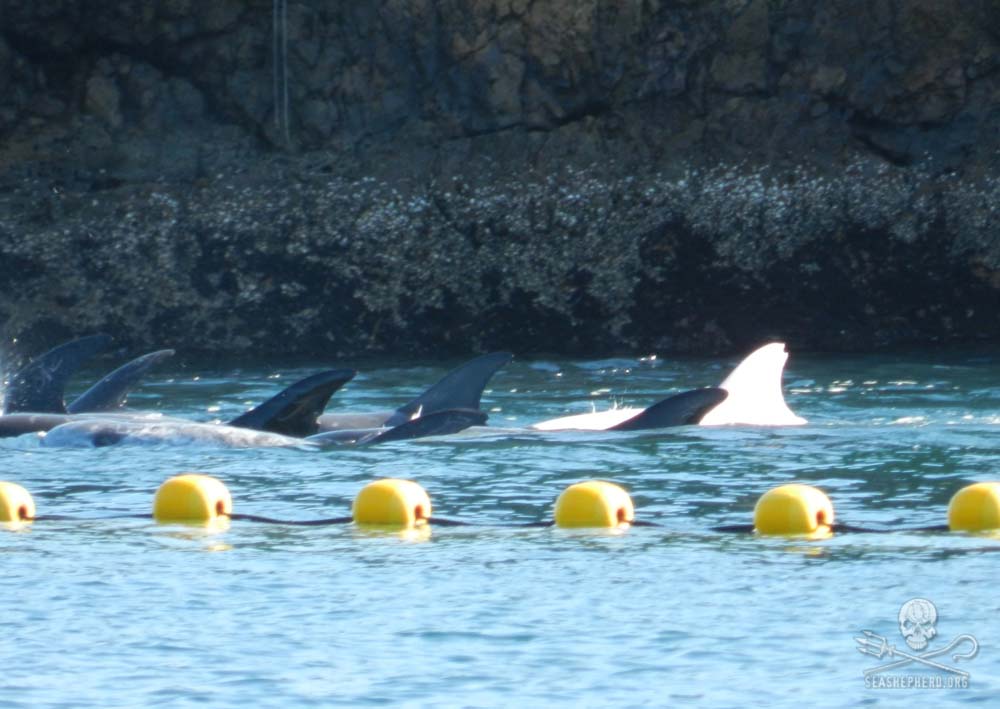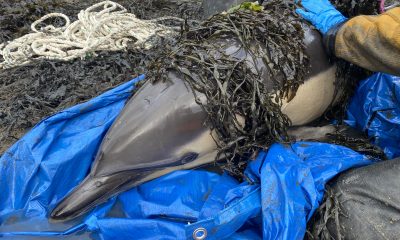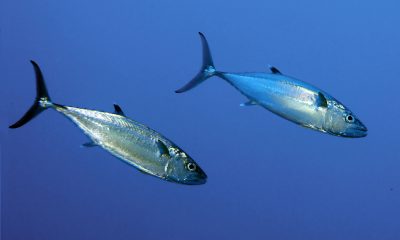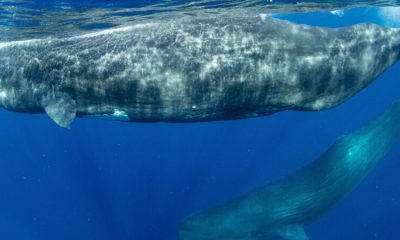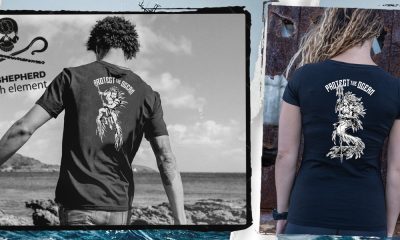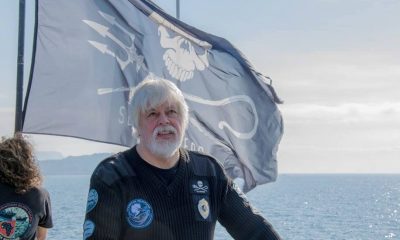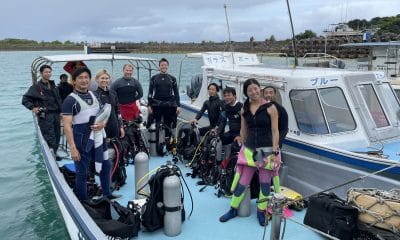News
A Special Report From Sea Shepherd’s Operation Henkaku
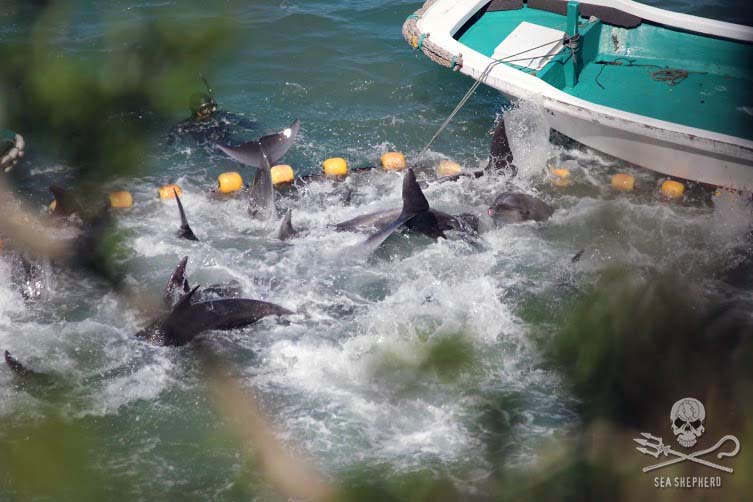
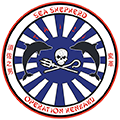 The 2015-2016 Taiji dolphin drive hunt is over. This season, the government of Wakayama Prefecture, Japan, authorized Taiji’s dolphin killers to capture or slaughter up to 1,873 dolphins. In some of the lowest numbers observed in recent years, between 630 and 650 dolphins were ruthlessly driven into the cove and slaughtered. Another 117 were taken captive, destined to spend the rest of their lives in shallow tanks, cement pools, or cramped sea pens performing circus tricks for paying tourists.
The 2015-2016 Taiji dolphin drive hunt is over. This season, the government of Wakayama Prefecture, Japan, authorized Taiji’s dolphin killers to capture or slaughter up to 1,873 dolphins. In some of the lowest numbers observed in recent years, between 630 and 650 dolphins were ruthlessly driven into the cove and slaughtered. Another 117 were taken captive, destined to spend the rest of their lives in shallow tanks, cement pools, or cramped sea pens performing circus tricks for paying tourists.
Sea Shepherd’s dedicated team of volunteer Cove Guardians was on the ground every single day of the hunt. Livestreaming the capture, selection, and slaughter, the Cove Guardians continued to bring international attention to this outrageous crime against the oceans. Despite ridiculous claims by those involved, the Taiji dolphin drive hunt is not tradition; it is a profit-driven enterprise supported by the Japanese government and fueled by the lucrative worldwide trade in captive dolphins.
Although several Cove Guardian veterans were barred entry into Japan, Sea Shepherd’s Cove Guardians stood their ground, as they have since 2010, to make sure the world sees exactly what Taiji tries to hide. The dolphin killers continued to use tarps to try to hide the killing from Sea Shepherd’s cameras, but tarps can’t hide the blood that turns the water from blue to red or the sounds of the frenzied dolphins as they face their executioners. Sea Shepherd’s livestream footage irrefutably dismissed any and all claims of a “humane slaughter.” During one slaughter, a pilot whale escaped from beneath the tarps after being pithed with a metal rod. For several minutes, the profusely bleeding and suffering animal attempted to swim away, eventually slipping under the surface of the water.
Each drive brought new horrific sights and each month was marked by even more merciless acts of violence on the part of the killers.
The annual hunt began on September 1, 2015. The first drive of the season ended with a pod of Risso’s dolphins netted into the cove on September 11. During the ensuing slaughter, the Cove Guardians observed one dolphin trying to escape by launching out of the water and up onto the jagged rocks in the killing cove. As some of the killers dragged the doomed dolphin back into the cove, others looked on and laughed at the plight of the terrified animal.
Following the slaughter of another pod of Risso’s dolphins on October 19, 2015, the killers dumped several bodies at sea. Sea Shepherd believe they took this extreme measure to avoid exceeding their annual Risso’s dolphin-killing quota. The next day, the Cove Guardians discovered the remains of a dead juvenile Risso’s dolphin washed-up on the beach.
November 19, 2015, began four days of anguish as approximately 69 – 74 pilot whales were captured and held in the cove. By November 22, 46 members of this intergenerational family had been slaughtered, and several more succumbed from the sheer stress of the drive and ensuing selection ordeal. One pilot whale was taken captive but died days later in a Taiji harbor sea pen.
December 2015 saw a pod of bottlenose dolphins captured and held in the cove for three days. Bottlenose is the dolphin species most prized by the captive industry. With the assistance of trainers, 30 animals were taken captive. Those dolphins not deemed to be “pretty” enough for captivity were slaughtered while the same trainers laughed and watched.
January always seems to be an especially bloody month in Taiji. This year was no exception.The killers hunted on 22 days and slaughtered pods on 14 of those days. Forty percent of the entire 2015-2016 killing quota was met in January 2016. Nine drives took place in February 2016, with 20 more bottlenose dolphins taken captive and forced into the tiny sea pens in Taiji harbor.
The 105 bottlenose dolphins, seven Risso’s dolphins, one pilot whale, and four Pacific white-sided dolphins taken into captivity during the 2015-16 Taiji dolphin hunt are now condemned to a dismal “life” as slaves to the captive industry. Forced to perform circus tricks in order to receive a reward of drug-laced frozen fish, many of these animals will die prematurely from stress, trauma or both.
The Taiji dolphin killers repeatedly claim that the dolphin drive hunt is their “tradition.” They also blame the dolphins for decreasing fish stocks and say that the drive hunt is a form of “pest control.” At the same time, they proclaim the pods of dolphins and whales who migrate through the waters of Taiji to be their property. In reality, the desire to hunt and capture dolphins has nothing to do with pest control or tradition. It has everything to do with greed. Captive dolphins are a multi-million-dollar worldwide industry that starts in Taiji, Japan.
The Taiji dolphin killers are profiting from a demand for captive dolphins. If you proudly display a photo kissing a captive dolphin, if you support marine parks and dolphinariums, you might as well stand alongside the killers in Taiji’s bloody cove. Your entrance fee to these places fuels the tanks for another hunt.
After five campaigns of Operation Infinite Patience, this season’s Operation Henkaku sought to focus specific attention on the captive trade. Taiji is all about supply and demand. The hunting and slaughter of dolphins will not end for good until the demand for captive dolphins ends for good.
While the grueling 2015 -2016 Taiji dolphin drive hunt season has now ended, the pressure on those who hold dolphins captive must not! Let’s close down the killing cove for good by bankrupting the worldwide captive trade. Dolphins are not assets, commodities or property. They don’t belong on transport trucks or cargo planes, and they certainly don’t belong in tanks. We must all continue to be a voice for the dolphins. Sea Shepherd have called on everyone who followed Operation Henkaku to keep pressuring travel agents, hotels, cruise lines, marine parks, and dolphinariums to stop profiting from the misery of captivity.
Tell everyone you know to “Just say NO to the dolphin show!”
For more information, visit Sea Shepherd’s Operation Henkaku site here.
Blogs
Northern Red Sea Reefs and Wrecks Trip Report, Part 2: Wall to Wall Wrecks

Jake Davies boards Ghazala Explorer for an unforgettable Red Sea diving experience…
The second day’s diving was a day full of wreck diving at Abu Nuhas, which included the Chrisoula K, Carnatic, and Ghiannis D. The first dive of the day was onto the Chrisoula K, also known as the wreck of tiles. The 98m vessel remains largely intact where she was loaded with tiles which can be seen throughout the hold. The stern sits at 26m and the bow just below the surface. One of the highlights of the wreck is heading inside and seeing the workroom where the machinery used for cutting the tiles are perfectly intact. The bow provided some relaxing scenery as the bright sunlight highlighted the colours of the soft coral reef and the many reef fish.

Following breakfast, we then headed to the next wreck, which was the Carnatic. The Carnatic is an 89.9m sail steamer vessel that was built in Britain back in 1862. She ran aground on the reef back in 1869 and remains at 27m. At the time, she was carrying a range of items, including 40,000 sterling in gold. An impressive wreck where much of the superstructure remains, and the two large masts lay on the seafloor. The wooden ribs of the hull provide structures for lots of soft corals, and into the stern section, the light beams through, bouncing off the large shoals of glass fish that can be found using the structure as shelter from the larger predators that are found outside of the wreck.

The final wreck at Abu Nuhas was the Ghiannis D, originally called ‘Shoyo Maru,’ which was 99.5m long and built in Japan back in 1969 before becoming a Greek-registered cargo ship in 1980. The ship then ran aground on the reef on April 19th, 1983, and now sits at the bottom at a depth of 27m. Heading down the line, the stern of the ship remains in good condition compared to the rest of the hull. The highlight of the wreck, though, is heading into the stern section and down the flights of stairs to enter the engine room, which remains in good condition and is definitely worth exploring. After exploring the interior section of the ship, we then headed over to see the rest of the superstructure, where it’s particularly interesting to see the large table corals that have grown at the bow relatively quickly considering the date the ship sank. After surfacing and enjoying some afternoon snacks, we made sure everything was strapped down and secured as we would be heading north and crossing the Gulf of Suez, where the winds were still creating plenty of chop.

The next morning, it was a short hop to Ras Mohammed Nature Reserve for the next couple of days of diving. The 6am wake-up call came along with the briefing for the first site we would be diving, which was Shark & Yolanda. The low current conditions allowed us to start the dive at Anemone City, where we would drift along the steep, coral-filled wall. These dives involved drifts, as mooring in Ras Mohammed wasn’t allowed to protect the reefs. As a dive site, Shark & Yolanda is well-known and historically had a lot of sharks, but unfortunately not so many in recent years, especially not so early in the season. However, there was always a chance when looking out into the blue.

The gentle drift took us along the steep walls of the site, with plenty of anemone fish to be seen and a huge variety of corals. It wasn’t long into the dive before we were accompanied by a hawksbill turtle, who drifted with us between the two atolls before parting ways. Between the two reefs, the shallow patch with parts of coral heads surrounded by sand provided the chance to see a few blue-spotted stingrays that were mainly resting underneath the corals and are always a pleasure to see. With this being the morning dive, the early sunlight lit up the walls, providing tranquil moments. Looking out into the blue, there was very little to be seen, but a small shoal of batfish shimmering underneath the sunlight was a moment to capture as we watched them swim by as they watched us.

Towards the end of the dive, we stopped at the wreck of the Jolanda where the seafloor was scattered with toilets from the containers it was carrying. This provided a unique site to make a safety stop, which was also accompanied by a large barracuda slowly swimming by, along with a hawksbill turtle calmly swimming over the reef as the sun rays danced in the distance.
For the next dive, we headed north to the Strait of Tiran to explore the reefs situated between Tiran Island and Sharm El Sheik, which were named after the British divers who had found them. We started on Jackson before heading to Gordons Reef, where we also did the night dive. All the atolls at these sites provided stunning, bustling coral reefs close to the surface and steep walls to swim along, which always provided the opportunity to keep an eye out for some of the larger species that can be seen in the blue. Midwater around Jackson Reef was filled with red-toothed triggerfish and shoals of banner fish, which at times were so dense that you couldn’t see into the blue. Moments went by peacefully as we enjoyed the slow drift above the reef, watching these shoals swim around under the mid-afternoon sun.

The night dive at Gordon’s Reef was mainly among the stacks of corals surrounded by sand, which was great to explore under the darkness. After some time circling the corals, we came across what we were really hoping to find, and that was an octopus hunting on the reef. We spent the majority of the dive just watching it crawl among the reef, blending into its changing surroundings through changes in colour and skin texture. It’s always so fascinating and captivating to watch these incredibly intelligent animals, in awe of their ability to carry out these physical changes to perfectly blend into the reef. Before we knew it, it was time to head back to the boat to enjoy a well-deserved tasty dinner prepared by the talented chefs onboard.
Check in for the 3rd and final part of this series from Jake tomorrow!
To find out more about the Northern Red Sea reef and wrecks itineraries aboard Ghazala Explorer, or to book, contact Scuba Travel now:
Email: dive@scubatravel.com
Tel: +44 (0)1483 411590
Photos: Jake Davies / Avalon.Red
Marine Life & Conservation
Double Bubble for Basking Sharks

 The Shark Trust is excited to announce that, for two more days only, all donations, large or small, will be doubled in the Big Give Green Match Fund!
The Shark Trust is excited to announce that, for two more days only, all donations, large or small, will be doubled in the Big Give Green Match Fund!
Donate to Basking in Nature: Sighting Giants
The Shark Trust is hoping to raise £10k which will be doubled to £20k. This will go towards Basking in Nature: Sighting Giants. And they need YOUR help to reach they’re goal.
The Shark Trust’s citizen science project is to monitor and assess basking sharks through sightings; encouraging data collection, community engagement, and promoting nature accessibility. This initiative aims to enhance health and wellbeing by fostering a deeper connection with British Sharks.
Campaign Aims
- Increase citizen science reporting of Basking Sharks and other shark sightings to help inform shark and ray conservation.
- Provide educational talks about the diverse range of sharks and rays in British waters and accessible identification guides!
- Create engaging and fun information panels on how to ID the amazing sharks and rays we have on our doorstep! These can be used on coastal paths around the Southwest. With activities and information on how you can make a difference for sharks and rays!
- Promote mental wellbeing through increasing time in nature and discovering the wonders beneath the waves!
Donate, and double your impact. Click Here
-

 News3 months ago
News3 months agoHone your underwater photography skills with Alphamarine Photography at Red Sea Diving Safari in March
-

 News3 months ago
News3 months agoCapturing Critters in Lembeh Underwater Photography Workshop 2024: Event Roundup
-

 Marine Life & Conservation Blogs2 months ago
Marine Life & Conservation Blogs2 months agoCreature Feature: Swell Sharks
-

 Blogs2 months ago
Blogs2 months agoMurex Resorts: Passport to Paradise!
-

 Blogs2 months ago
Blogs2 months agoDiver Discovering Whale Skeletons Beneath Ice Judged World’s Best Underwater Photograph
-

 Gear Reviews2 months ago
Gear Reviews2 months agoGear Review: Oceanic+ Dive Housing for iPhone
-

 Marine Life & Conservation2 months ago
Marine Life & Conservation2 months agoSave the Manatee Club launches brand new webcams at Silver Springs State Park, Florida
-

 News3 months ago
News3 months agoWorld’s Best Underwater Photographers Unveil Breathtaking Images at World Shootout 2023


